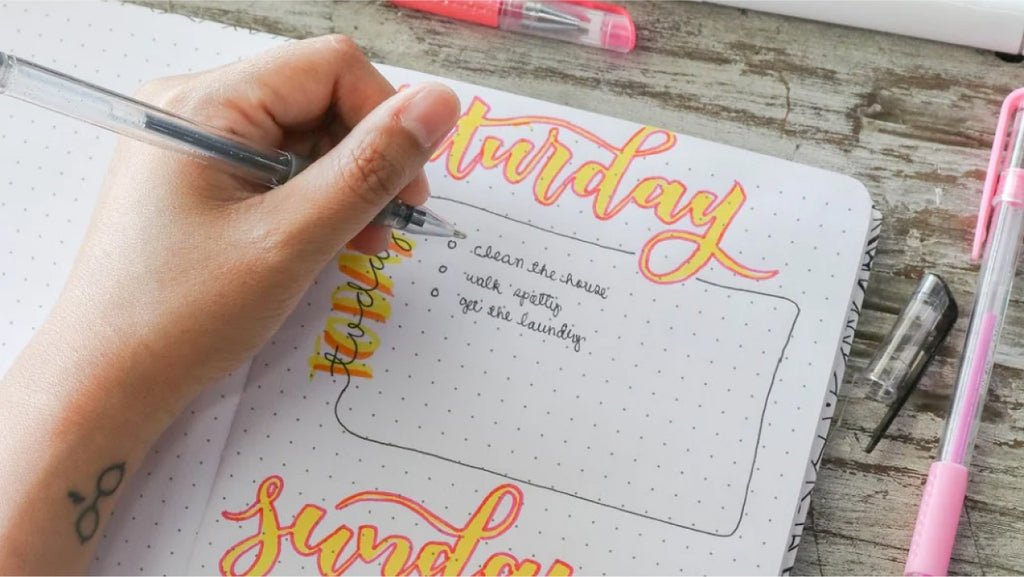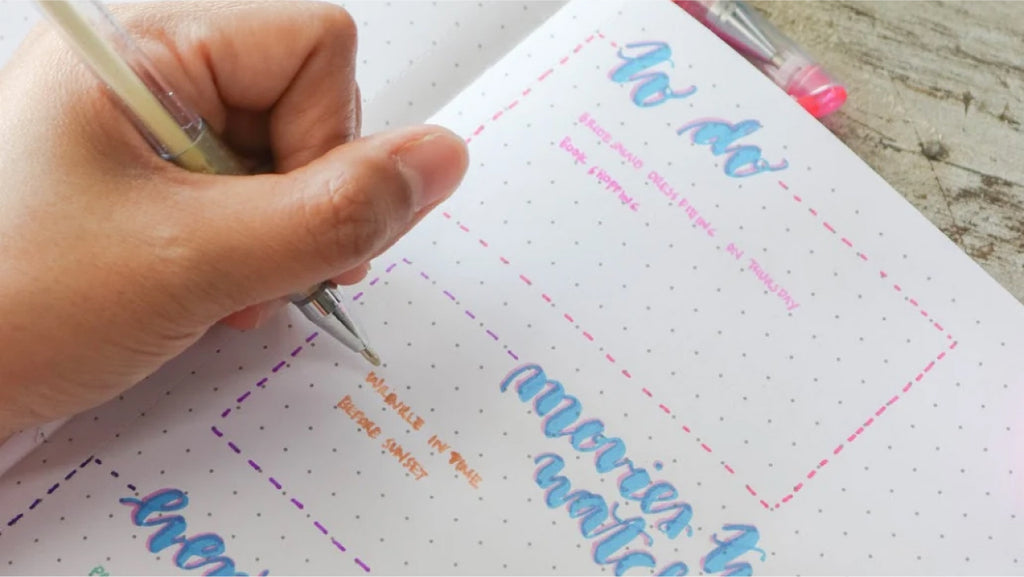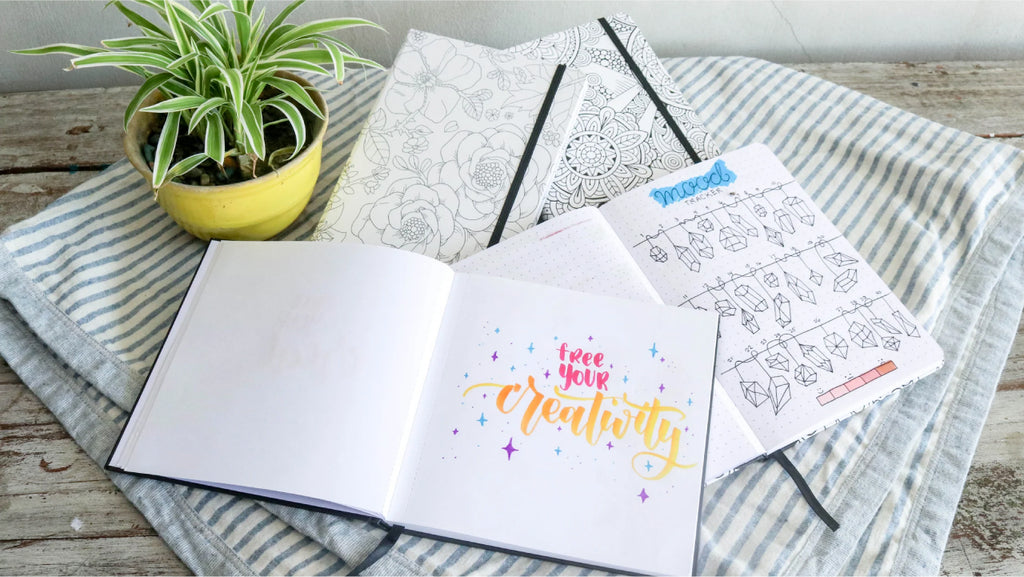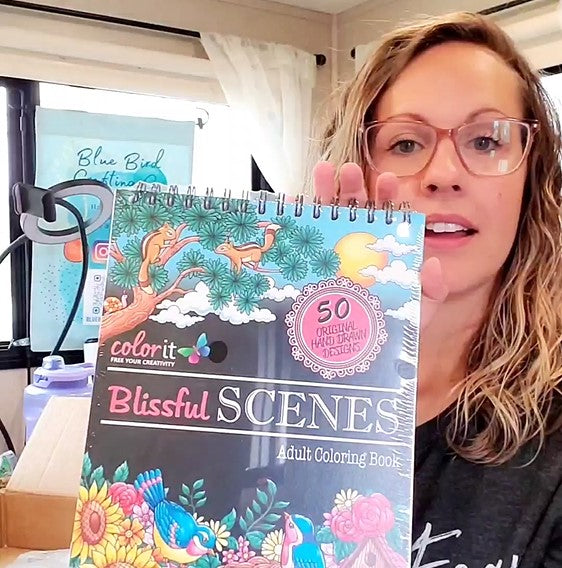How to Start a Bullet Journal—and Get Your Life in Order
Posted by ColorIt Support on

Get more organized.
This is probably one of the most common resolutions everyone makes at the beginning of the year (which is often said in the same breath as eating healthy, saving money, and getting fit).
Well, we’re now into the third quarter of the year—so how’s your New Year’s resolution holding up?
If you’re like most people, then chances are you started the year with the best of intentions and the greatest ambitions...only to find yourself back to square one, rushing through your days and racing around from one task to another as regular life reasserts itself and the initial outburst of motivation eventually wears off.
It’s easy to become frustrated and discouraged when this happens.
Fortunately, it’s never too late to get your organization act together!
One thing you can try to get your life back on track while freeing your creativity at the same time, is starting a bullet journal.
What is a Bullet Journal?
A bullet journal (also known as BuJo) isn’t your conventional planner or organizer. It’s a system devised by Ryder Carroll, a New York-based digital product designer, that combines note-taking, planning, scheduling, journaling, and more. Carroll calls the Bujo as “an analog system for the digital world.”
What’s great about bullet journaling is that it’s incredibly versatile and highly customizable. It can be used to track everything specific to your life—from your daily to-dos, habits, savings, notes to self, long-term goals, monthly calendars, and more.
You can also decide how it looks. For example, the bullet journal was initially introduced as a relatively minimalist and distraction-free system. Over time, though, it has evolved significantly, and many bullet journalists now create artistic pages (also known as spreads) filled with doodles and drawings, as well as fancy lettering and calligraphy.
In other words, the bullet journal is the chameleon of planning and organization. It can take on any form and be whatever you want it to be.
Who is a Bullet Journal for?
So now that you know what a bullet journal is, the next question is: will it be a good fit for you?
Well, are you someone who:
- Wants to become or stay more organized?
- Needs a new creative outlet?
- Loves journaling, scrapbooking, stationery, beautiful pens, etc.?
- Is obsessed with notebooks and planners?
- Has a million to-do lists written separately in notebooks, apps, or post-its?
- Wants to disconnect from technology and get organized the old-school way?
- Wants to set, track, and accomplish goals?
- Wants to keep track of eating, sleeping, exercise, or spending habits?
If you said yes to one (or all) of the things listed above, then maybe you should give bullet journaling a try! But of course, there’s really no requirement for liking BuJo. Even if you cannot relate to any of the things we mentioned above, but are curious about how this organization system works, then feel free to set up your own BuJo!
Do Bullet Journals Work?
With so many planners and productivity tools and apps available today, why start a bullet journal? How does this organization system benefit newbie and seasoned planners alike?
Let us count the ways.
-
You’re in control of everything that goes in your journal
One of the best things about a bullet journal is that you have complete control over what goes in it. You get to choose how to format the spread so that it fits your needs and wants. You can have your weekly planner on one page, then have your habit tracker on the next page, or dedicate another page to put an inspiring quote or maybe a list of your favorite movies. Anything goes! BuJos afford you the freedom and flexibility that other pre-printed planners do not offer.

-
It’s easy to get started
Looking at other’s bullet journal spreads on Instagram, Pinterest, or Youtube can feel overwhelming and discouraging, especially if you feel like you lack the artistic skill to maintain it. Carroll, however, offers a piece of advice:
“Forget about what you see online. It’s not about how it looks; it’s about how it feels, and, most importantly, how it works for you.”
So there, you heard it from the BuJo creator himself. To get started, the basic things you need are a handy-dandy notebook and a pen! That’s it. Anything else is just a bonus! (If you want to get started ASAP, then read on to the next section.
-
It lets you prioritize tasks
The beauty of the bullet journal is that it enables you to record all of your tasks and assign each of them within a specific time frame. You can write everything you need or want to do each day in the daily log, or in a month in the monthly log. You can also list long-term goals you want to accomplish or any significant events you're planning to attend in your future log.
By breaking down all of your tasks per day or month, instead of writing all of your tasks in one, big, to-do list, you can avoid the all-too-common dilemma of tackling the easy [translate: unimportant] tasks first rather than working on the most important items on your list.
- It drives productivity
You know what’s more satisfying than being able to visualize your tasks? Getting to check things off your list! A BuJo is a great way to drive productivity because it helps you to keep track of your to-do list, which leaves you little room for idleness.
-
It allows you to reflect
Another benefit that BuJo users can reap is the ability to check in with oneself. We live in a world where our attention is constantly sought by that little red notification badge, begging us to check out what others are saying or what they’re up to lately. And before we know it, we’d already have lost an hour or two just mindlessly scrolling on social media.
By picking up a paper notebook instead of your gadgets to add your thoughts or plans, you can better focus on the task at hand and externalize your thoughts.
- It helps free your creativity
Your bullet journal can become much more than your daily planner. It can also help you exercise your creativity. Just because it’s called a “journal” doesn’t mean all you have to do is write. Stretch your creativity muscles by sketching, doodling, or experimenting with lettering and calligraphy. A set of high quality colored pens or pencils can come in handy!

-
It improves your memory
Another advantage that bullet journaling has over digital tools is memory retention. When you maintain a bullet journal, you will get back to basics and write by hand. This practice engages multiple senses (such as visual, kinesthetic, and tactile) which, as various studies have suggested, is crucial to committing tasks to memory.
- It keeps everything in one place
How to Get Started with Bullet Journaling
“We’re way past the middle of the year. Can I still start a bullet journal?”
Of course! It’s never too late to get rid of chaos and welcome order and creativity to your life!
In this section, we’ll show you everything you need to get started.
1. Gather your supplies
As we have previously mentioned, all you need to get started with bullet journaling is a notebook and a writing tool. You can go ahead and pick any spare notebook you have, or get one specially made for bullet journaling. We recently added a collection of new bullet journals to the ColorIt family, which feature dot grid pages in thick, quality papers, that are perfect for this new creative endeavor!

Of course, there are so many other supplies that you can use for your BuJo, such as washi tapes, stamps, and stickers, but you can experiment on them later.
2. Let go of perfection
There is no one right way to bullet journal. Some may stick to the original BuJo method, while others may create their own version of the system. It may take a bit of trial-and-error before you can find a system that works for you and actually help you keep organized. The important thing is that you remember that BuJo is never about perfection. It’s okay to make a mess and focus on function more than form, especially in your first notebook.
3. Learn the basics
Below are some of the BuJo terms you need to know:
- Rapid logging - Carroll describes rapid logging as “the language in which the Bullet Journal is written.” It basically advocates for simplicity—that means using bullets, short sentences, page numbers, and topics instead of writing long sentences to record important information.
- Index - As we have previously mentioned, the Index serves as your journal’s table of contents. It should include a list of all your BuJo entries and their corresponding page numbers (which means that you need to number your pages). You need to update your index as you go so you can easily find what you need when you need it.
- Future Log - this refers to the list of tasks that needs to be done months in advance, or things you hope to accomplish someday.
- Monthly Log - This includes a categorized list of goals or plans for the next 30 days.
- Daily Log - Here, you can be more specific and write down to-dos, meetings, and reminders.
- Collections - These are essentially anything and everything you want to remember for later, which may not fit one of the previously mentioned categories. Popular collections include books or movies you want to read, self-care ideas, things you’re grateful for, recipes to try, habit tracker, and more.
- Bullets - These are symbols you use to categorize your entries.
Dots (•) can be used to indicate tasks.
Other symbols for tasks include:
X = Task Completed
> = Task Migrated
< = Task Scheduled
Circles (O) for events.
Dashes (–) for notes, ideas, and thoughts.
- Signifiers - These are additional symbols you can use to categorize your entries and give them more context. Common signifiers include:
Asterisk (*) to mark priority tasks
Exclamation point (!) to highlight ideas or inspiration.
Eye to indicate items that require further research or exploration.
- Migration - This is the filtering system of your BuJo. At the end of every month, check your previous entries and look at undone tasks and events. If they are still relevant, you have the option to migrate them to the new month using the symbol “>” to indicate that you’ve moved them to another month.
4. Set up your bullet journal
So now that you are familiar with the basic framework, it’s time to put the pieces together!
- Create an index
First things first, set aside two pages to serve as your index. You can make your index as basic or as fancy as you want it to be. The important thing is you have a place where you can list all of your entries and track their corresponding page numbers.
- Create a future log
Next, draft up your future log. This section is similar to your yearly calendar, where you write down all the important dates for the entire year. This could include your goals, appointments, holidays, and other important occasions and dates. Make sure to add the page number of your future logs to your index.
- Create your monthly spread
Your monthly log is a lot like your monthly calendar--you simply list all of the tasks you need to accomplish in a month, along with the dates you want to get them done. There are endless ways of creating your monthly spread. Check out this cool tutorial on how to set up your monthly spread:
- Create your daily log
- Create your collection pages
Check out some of these cool ideas for setting up your Collections:
5. Make time for it
Setting up your BuJo is the easy part, maintaining and making time for it? Now that’s the challenge! Remember that no productivity system will work unless you roll up your sleeves and get to business, so always make it a point to refer to your journal on a daily and monthly basis as you complete your tasks. Doing a monthly or quarterly review of your BuJo also helps to give you a sense of accomplishment, which in turn boosts your confidence and self-esteem.
More Tips and Tricks
Bullet journaling offers tons of benefits to both newbie and seasoned planners. But for you to truly enjoy the experience, there are a couple of tips you need to keep in mind.
- Go slow - When you start a bullet journal for the first time, you might be tempted to try out all the formats, designs, and collections you can think of. Hold your horses! Doing everything at once could turn out badly; you might end up just scrapping the whole thing altogether! Better start simple first and stick to the basics. Work on them for a while until you pick up your pace and eventually learn what works for you and what doesn’t.
- Borrow ideas, but don’t compare - You can find tons of sources of inspiration for bullet journaling online. While you certainly can borrow ideas from other BuJo enthusiasts, be careful about comparing your work to others. It’s fine even if your notebook isn’t dressed for the Oscar’s like the others with their perfectly illustrated headers and intricate charts. It’s not meant to impress people, anyway. Rather it’s a tool to help you externalize your thoughts, plan your day, and track your tasks and goals. It’s about designing life in your own terms.
- Invest in good supplies - While it’s true that you can practically grab any notebook and pen to get started with your BuJo, using high-quality supplies can add a little motivation to your practice. Plus, you’ll rest easy knowing your notebook won’t fall apart just when you’ve just got the hang of it!

What do you like about bullet journaling? Tell us in the comments below.
Share this post
- 2 comments
- Tags: bullet journal, bullet journal setup, bullet journal system, coloring tips, journal
2 comments








I had never heard of a bullet journal until today & I must say this is a great idea to get your life back in order! I’m definitely going to try one as soon as I get home from work.
Thanks for the great ideas,
Diane
I have never heard of a Bullet Journal but after reading about it I will definitely start one asap! It will be great for me to finally get organized; with my own style and colors! Thank you Thank you Thank you!!!